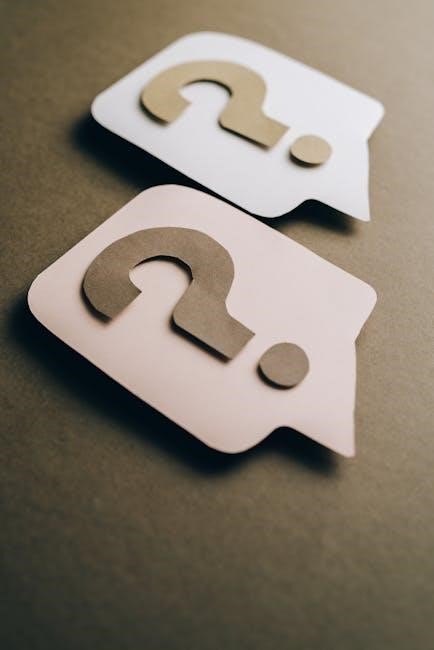ions worksheet answer key pdf
Ions are charged particles formed when atoms gain or lose electrons, essential in chemistry for understanding compounds and reactions. Worksheets with answer keys provide practice in identifying and forming ions, helping students master ion chemistry fundamentals.
1.1 What is an Ion?
An ion is a charged particle formed when an atom gains or loses electrons, resulting in a net positive or negative charge. Positively charged ions are called cations, while negatively charged ions are anions. Ions can consist of single atoms or groups of atoms (polyatomic ions). Understanding ions is fundamental in chemistry, as they play a crucial role in chemical bonding, reactions, and the formation of ionic compounds. Worksheets and answer keys provide practical exercises to identify and classify ions, aiding students in mastering ion chemistry concepts effectively.
1.2 Importance of Understanding Ions
Understanding ions is essential for grasping fundamental chemistry concepts, such as chemical bonding, reactions, and the structure of matter. Ions play a critical role in the formation of ionic compounds and are vital in various scientific fields, including biology, medicine, and environmental science. Recognizing ions and their properties helps predict compound solubility, electrical conductivity, and chemical behavior. Practicing with worksheets and answer keys enhances students’ ability to identify, classify, and apply ion-related knowledge effectively in academic and real-world scenarios, making it a cornerstone of chemistry education.
Formation of Ions
Ions form when neutral atoms gain or lose electrons, resulting in a net positive or negative charge. This process is fundamental to understanding ion chemistry.
2.1 How Ions are Formed from Neutral Atoms
Ions form when neutral atoms lose or gain electrons to achieve a stable electronic configuration, resembling noble gases. Cations form through electron loss, typically by metals with low ionization energy, while anions form via electron gain, common in non-metals with high electron affinity.
2.2 Why Ions Form: Gaining or Losing Electrons
Ions form to achieve electronic stability, often by gaining or losing electrons to mimic noble gas configurations. Metals typically lose electrons to form cations, as their valence shells are nearly empty. Nonmetals gain electrons to form anions, completing their valence shells. This process stabilizes the atom, reducing its energy state. For example, sodium (Na) loses an electron to become Na⁺, while chlorine (Cl) gains one to become Cl⁻. This electron transfer drives ion formation, enabling chemical bonding and compound creation.
Types of Ions
Ions are classified into cations (positively charged) and anions (negatively charged). Cations form when atoms lose electrons, while anions form when atoms gain electrons; Common examples include Na⁺ (sodium) and Cl⁻ (chloride).
3.1 Cations: Positively Charged Ions
Cations are positively charged ions formed when neutral atoms lose one or more electrons. Common examples include alkali metals like Na⁺ and K⁺, and alkaline earth metals like Ca²⁺. Worksheets often involve identifying cations and their charges, with answer keys providing correct formulas and names. Students practice matching elements to their respective cations, ensuring understanding of periodic trends in ion formation. This skill is crucial for identifying ionic compounds and their properties in chemistry.
3.2 Anions: Negatively Charged Ions
Anions are negatively charged ions formed when neutral atoms gain one or more electrons. Common examples include halides like Cl⁻ and O²⁻, as well as sulfide (S²⁻) and carbonate (CO₃²⁻). Worksheets often include exercises where students identify anions and their charges, with answer keys providing correct formulas and names. These exercises help students understand periodic trends and the role of anions in forming ionic compounds. Mastering anions is essential for predicting chemical reactions and compound properties in chemistry.

Polyatomic Ions
Polyatomic ions are groups of atoms bonded together with an overall charge. Examples include sulfate (SO₄²⁻) and nitrate (NO₃⁻). Worksheets with answer keys help students recognize and name these ions, ensuring accuracy in formulas and nomenclature for ionic compounds.
4.1 Definition and Examples of Polyatomic Ions
Polyatomic ions are clusters of two or more atoms bonded together, carrying a collective charge. For instance, sulfate (SO₄²⁻) and nitrate (NO₃⁻) are common polyatomic ions. Worksheets provide exercises to identify and name these ions, enhancing understanding of their structures and charges. These exercises are supported by answer keys, ensuring students can verify their work and improve their ability to write correct formulas for polyatomic ions in ionic compounds. This practice is crucial for mastering chemistry concepts related to ion formation and compound nomenclature.
4.2 Common Polyatomic Ions (e.g., Sulfate, Nitrate)
Common polyatomic ions include sulfate (SO₄²⁻), nitrate (NO₃⁻), carbonate (CO₃²⁻), and phosphate (PO₄³⁻). Worksheets often feature these ions, providing practice in naming and writing their formulas. Answer keys help students verify their responses, ensuring accurate identification of these ions. Regular practice with these ions enhances understanding of their roles in ionic compounds, a fundamental skill in chemistry. These exercises are essential for building proficiency in ion chemistry and preparing for more complex topics.

Identifying Ions
Identifying ions involves determining their charge and type (cation or anion). Worksheets with answer keys provide exercises to practice naming and writing ion formulas accurately.
5.1 Determining the Charge of an Ion
Determining the charge of an ion involves understanding electron gain or loss. Cations form when atoms lose electrons, while anions form by gaining electrons. Elements near noble gases often form anions. Worksheets guide students in calculating ion charges and naming them, with answer keys providing correct solutions for practice exercises. This skill is crucial for writing correct ion formulas and understanding ionic compounds. Regular practice helps students master ion charge determination, enhancing their chemistry skills effectively.
5.2 Writing the Formula of an Ion
Writing the formula of an ion requires understanding the element’s tendency to lose or gain electrons. Cations are formed by losing electrons, while anions are formed by gaining them. For example, sodium becomes Na⁺, and chloride becomes Cl⁻. Polyatomic ions, like sulfate (SO₄²⁻), must be memorized. The charge is indicated as a superscript. Worksheets with answer keys provide practice in determining and writing ion formulas, helping students master this fundamental chemistry skill effectively.
Isotopes and Ions
Isotopes are atoms of the same element with different neutron numbers, sharing the same atomic number. They influence ion formation by maintaining consistent electron counts, affecting charge stability.
6.1 Relationship Between Isotopes and Ion Formation
Isotopes, atoms with varying neutron counts, share the same atomic number and chemical properties. This consistency allows isotopes to form ions similarly, maintaining predictable charges and behaviors in reactions, essential for understanding ion chemistry in worksheets and practical applications;
6.2 Isotopes vs. Ions: Key Differences
Isotopes are atoms of the same element with differing neutron numbers, retaining the same chemical properties. Ions are charged particles formed by electron gain or loss, altering an atom’s charge but not its elemental identity. While isotopes vary in mass, ions differ in charge, each concept crucial for understanding atomic structure and chemical behavior in educational worksheets and practical applications.

Elements and Ion Formation
Elements’ positions on the periodic table influence their ion formation tendencies. Metals typically lose electrons to form cations, while nonmetals gain electrons to form anions. Noble gases rarely form ions due to their stable electron configurations.
7.1 Elements That Tend Not to Form Ions
Certain elements, such as noble gases, rarely form ions due to their stable electron configurations. These elements have full valence shells, making it energetically unfavorable to gain or lose electrons. For example, helium and neon are monatomic and chemically inert, minimizing their tendency to form ions. Similarly, elements in group 18 of the periodic table exhibit similar properties, as their electron arrangements are already stable. This stability reduces their reactivity and ion-forming potential, making them exceptions in ion chemistry.
7.2 Elements That Commonly Form Ions
Elements that commonly form ions include metals like sodium, calcium, and aluminum, which readily lose electrons to form cations. Nonmetals such as oxygen, chlorine, and sulfur often gain electrons to become anions. Transition metals like iron and copper can form multiple ions with different charges. These elements tend to form ions due to their electron configurations, which make it energetically favorable to gain or lose electrons. Worksheets often highlight these elements, helping students identify patterns in ion formation based on periodic trends and chemical reactivity.
Periodic Trends and Ion Formation
Periodic trends influence ion formation, with ionization energy and electron affinity varying across periods and groups. Atomic size and electronegativity play key roles, guiding cation and anion formation tendencies.
8.1 How Atomic Structure Influences Ion Formation
Atomic structure significantly impacts ion formation, as the arrangement of electrons determines how easily atoms gain or lose electrons to form ions. The number of valence electrons, electron configuration, and ionization energy play crucial roles. Elements with low ionization energy tend to lose electrons, forming cations, while those with high electron affinity gain electrons, forming anions. The periodic table’s trends, such as atomic size and electronegativity, also influence these processes, guiding predictable patterns in ion formation across different elements.
8.2 Periodic Trends in Ionization Energy and Electron Affinity
Ionization energy and electron affinity exhibit periodic trends, influencing ion formation. Ionization energy increases across a period and decreases down a group, reflecting the ease of losing electrons. Similarly, electron affinity generally increases across a period and decreases down a group, indicating the tendency to gain electrons. These trends help predict which elements form cations or anions. For example, elements like oxygen and fluorine have high electron affinity, forming anions, while alkali metals have low ionization energy, forming cations. Understanding these trends aids in predicting ion formation patterns.

Ionic Compounds
Ionic compounds form through the transfer of electrons between atoms, creating cations and anions that attract each other. Their formation and naming are essential topics in ion chemistry.
9.1 Formation of Ionic Compounds
Ionic compounds form when metals transfer electrons to nonmetals, creating ions with opposite charges. This process involves the complete transfer of valence electrons, resulting in a stable ionic bond. The metal typically becomes a positively charged cation, while the nonmetal becomes a negatively charged anion. This transfer ensures the stability of both ions, as they achieve a full valence shell configuration. Worksheets with answer keys provide exercises to practice identifying and writing the formulas of these compounds, reinforcing understanding of ionic bonding principles. These exercises are crucial for mastering ion chemistry and preparing for more advanced topics in chemical bonding. By completing these worksheets, students gain proficiency in predicting the formation of ionic compounds and their chemical formulas. This foundational knowledge is essential for understanding more complex chemical reactions and structures in later studies. The use of answer keys allows for self-assessment, ensuring students can identify and correct any misunderstandings. Regular practice with these exercises helps solidify the concepts of ionic compound formation, making it easier to apply this knowledge in various chemical contexts. Additionally, understanding the principles behind ionic bonding is vital for grasping related topics such as solubility rules and the behavior of ionic substances in different solutions. The systematic approach provided by these worksheets enables students to build a strong foundation in ion chemistry, which is critical for success in chemistry courses. By focusing on the formation of ionic compounds, students develop essential skills in chemical analysis and nomenclature. These skills are not only necessary for academic success but also for practical applications in fields such as materials science and pharmacology. Overall, the study of ionic compound formation through structured worksheets and answer keys is a cornerstone of chemical education, providing students with the tools to explore and understand the molecular world.
9.2 Naming Ionic Compounds
Naming ionic compounds involves combining the name of the cation (metal) with the name of the anion (nonmetal), modified to end in “-ide.” For single-charge cations, the name remains the same, while anions are derived from the nonmetal’s name. Polyatomic ions retain their names, and Greek prefixes are used for those with multiple forms. Transition metals with variable charges require Roman numerals in parentheses to indicate their charge. Worksheets with answer keys provide exercises to practice naming ionic compounds, ensuring mastery of nomenclature rules and chemical terminology. These exercises help students develop accuracy in identifying and naming compounds, reinforcing their understanding of ion chemistry. Regular practice with these resources builds confidence and proficiency in chemical naming, a critical skill for success in chemistry. The structured approach of these worksheets, combined with answer keys, allows students to self-assess and refine their skills effectively. This foundational knowledge is essential for advancing in chemistry and applying these principles to more complex compounds and reactions. By mastering the naming of ionic compounds, students gain a solid understanding of chemical structure and composition. This skill is invaluable for future studies in chemistry and related fields, where precise communication of chemical names is required. The use of worksheets and answer keys ensures that students can practice and perfect their skills in a guided and efficient manner. Overall, naming ionic compounds is a fundamental aspect of chemistry education, and these resources provide an excellent way to achieve proficiency.
Solubility Rules for Ionic Compounds
Solubility rules predict whether ionic compounds dissolve in water. Worksheets with answer keys provide tables and exercises to apply these rules, aiding in solubility prediction for compounds like nitrates and sulfates.
10.1 Solubility Rules Table
A solubility rules table is a chart that outlines whether ionic compounds are soluble or insoluble in water. Common rules include nitrates being soluble, group 1 cations forming soluble salts, and most sulfides being insoluble. The table categorizes compounds based on their ions, such as sulfates, carbonates, and hydroxides. Worksheets often include these tables to help students predict solubility. Answer keys provide correct predictions, ensuring mastery of solubility trends for compounds like sodium nitrate or calcium carbonate.
10.2 Applying Solubility Rules to Predict Compound Solubility
Using solubility rules, students can predict whether ionic compounds will dissolve in water. For example, nitrates and group 1 cations typically form soluble compounds, while sulfides and carbonates are often insoluble. By referencing the solubility table, learners can determine if compounds like NaNO₃ (soluble) or CaCO₃ (insoluble) will dissolve. Worksheets with answer keys provide exercises to apply these rules, ensuring accurate predictions and a strong understanding of solubility trends in ionic compounds.
Worksheet Practice
Worksheet practice helps students master ion concepts by identifying ions, writing formulas, and understanding formation. It covers cations, anions, and polyatomic ions, with answer keys for self-assessment.
11.1 Completing the Ions Worksheet
Completing the ions worksheet involves identifying ions, their charges, and understanding their formation. Students analyze elements like lithium (Li) and nitrogen (N), determining if they form cations or anions. For example, Li loses one electron to become Li⁺, while N gains three electrons to form N³⁻. Worksheets often include charts for elements, their valence electrons, and the ions they form. This practice helps students master ion formation rules and prepares them for more complex chemistry topics. Answer keys provide correct solutions for self-assessment and understanding. Regular practice ensures proficiency in identifying and naming ions accurately.
11.2 Using the Answer Key for Self-Assessment
Using the answer key for self-assessment allows students to verify their understanding of ion formation and identification. By comparing their worksheet answers to the key, they can identify errors and understand common mistakes, such as misidentifying cations or anions. The answer key provides clear explanations and correct formulas for ions, enabling students to learn from their mistakes. Regular use of the answer key improves problem-solving skills and ensures mastery of ion-related concepts. It also builds confidence for more complex chemistry challenges ahead.
Common Mistakes in Ion Worksheets
Common mistakes include misidentifying cations and anions, incorrect ion charge calculations, and errors in writing ion formulas. These errors often stem from misunderstanding atomic structure and electron transfer.
12.1 Misidentifying Cations and Anions
One common mistake is misidentifying cations and anions. Cations are positively charged ions, typically formed by metal atoms losing electrons. Anions, negatively charged, usually form when non-metals gain electrons. Students often confuse the two, incorrectly labeling charges or assigning incorrect signs. This error stems from misunderstanding electron transfer and the periodic trends that predict ion formation. Worksheets with answer keys highlight these mistakes, helping students recognize the difference and improve their understanding of ion charges and types.
12.2 Errors in Writing Ion Formulas
Common errors include incorrect charge balance, such as writing Na₂O instead of Na₂O₂, or misrepresenting polyatomic ions like sulfate (SO₄²⁻) as SO₄. Students often confuse ion charges, especially for transition metals, which can have multiple oxidation states. Additionally, errors arise from incorrect placement of charges, such as writing O²⁻ instead of O²⁻. Answer keys in worksheets highlight these mistakes, providing correct formulas and explanations to help students master ion notation and avoid future errors in their chemistry assignments.
Real-World Applications of Ion Chemistry
Ions play a crucial role in biology, medicine, and industry, influencing processes like nerve signaling, water purification, and battery technology. Understanding ion behavior is essential for advancing these fields and developing new technologies.
13.1 Ions in Biology and Medicine
Ions are vital in biological systems, regulating nerve impulses, muscle contractions, and fluid balance. Essential ions like sodium, potassium, calcium, and chloride maintain cellular functions. In medicine, ions are used in IV solutions, electrolyte treatments, and diagnostic tools. Understanding ion behavior aids in treating conditions like heart arrhythmias and electrolyte imbalances. Their role in enzyme function and pH regulation highlights their importance in sustaining life and advancing medical treatments.
13.2 Ions in Industrial and Environmental Applications
Ions play a crucial role in industrial processes and environmental systems. In manufacturing, ions are used in electroplating, corrosion prevention, and battery production. Water treatment plants utilize ion exchange to remove impurities, improving water quality. The chemical industry relies on ions for producing acids, bases, and salts. Environmental monitoring involves tracking ion concentrations to assess air and water pollution. Understanding ion behavior aids in developing sustainable technologies, ensuring efficient resource use, and promoting environmental safety, making them indispensable in both industrial and ecological applications.
The Importance of Understanding Ions
Understanding ions is fundamental to chemistry, as they drive chemical reactions, conductivity, and biological processes. Mastering ion concepts aids in predicting compound behavior and solving practical problems effectively.
14.1 Ions in Chemical Reactions
Ions play a critical role in chemical reactions by facilitating the transfer of charge and enabling the formation of new compounds. They often act as reactants or products, influencing reaction dynamics. For instance, in aqueous solutions, ions such as Na⁺ and Cl⁻ participate in ionic bonding, forming salts like NaCl. Understanding ionic behavior is key to predicting reaction outcomes, as seen in solubility rules and electrochemical processes. Worksheets with answer keys help students analyze these interactions, enhancing their ability to balance equations and identify reaction types.
14.2 Ions and Their Role in Conductivity
Ions are essential for conductivity in solutions and materials, acting as charge carriers that facilitate the flow of electrical current. In conductive solutions, ions like Na⁺ and Cl⁻ move freely, allowing electricity to flow. This property is crucial in electrolytic cells and batteries. Ions also influence the conductivity of metals and semiconductors, where their movement enables electronic devices to function. Understanding ionic conductivity is vital for applications in electronics, medicine, and energy storage. Worksheets with answer keys help students explore these principles, ensuring a solid grasp of ionic behavior in conductive systems.
Mastering ion chemistry is essential for understanding chemical reactions and compounds. Worksheets with answer keys provide practical tools for learning ion formation and properties, ensuring academic success.
15.1 Summary of Key Concepts
15.2 Final Tips for Mastering Ion Worksheets
To excel in ion worksheets, focus on understanding the basics of ion formation and charges. Practice identifying cations and anions, and memorize common polyatomic ions. Review solubility rules to predict compound solubility accurately. Use answer keys to self-assess and correct mistakes. Break down complex problems into simpler steps, ensuring clarity in writing ion formulas. Regular practice and reviewing key concepts will build confidence and mastery in handling ion-related tasks effectively.


